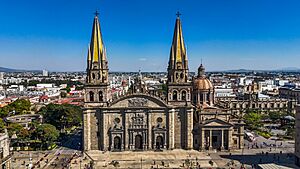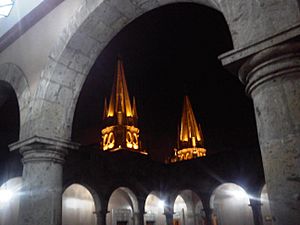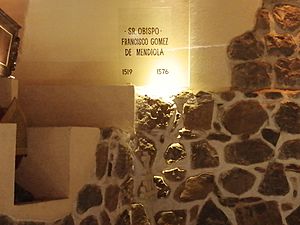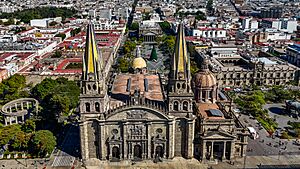Guadalajara Cathedral facts for kids
Quick facts for kids Guadalajara Cathedral |
|
|---|---|
| Cathedral-Basilica of the Assumption of Our Lady | |
|
Catedral Basílica de la Asunción de María Santísima (Spanish)
|
|

Guadalajara Cathedral
|
|
| Location | Guadalajara, Mexico |
| Denomination | Catholic |
| Tradition | Roman Rite |
| History | |
| Status | Cathedral, Minor basilica |
| Dedication | Assumption of Mary |
| Architecture | |
| Architect(s) | Martín Casillas Manuel Gómez Ibarra |
| Style | Spanish Renaissance |
| Groundbreaking | 31 July 1561 |
| Completed | 1618 |
| Administration | |
| Archdiocese | Guadalajara |
The Guadalajara Cathedral is also known as the Cathedral of the Assumption of Our Lady. In Spanish, it's called Catedral de Guadalajara or Catedral de la Asunción de María Santísima. This important building is located in Guadalajara, Jalisco, Mexico.
It serves as the main church for the Roman Catholic Archdiocese of Guadalajara. It is also a minor basilica, which is a special title given by the Pope. The cathedral was built in the Spanish Renaissance style. However, its tall, pointed towers are in a different style called neo-Gothic.
Contents
History of the Cathedral
Building the First Church
The very first church on this site was built in 1541. It was located where the Templo de Santa Maria de Gracia stands today. This early church was quite simple. It was made from adobe bricks and had a roof of straw.
In 1548, the area became a diocese by the Holy See. This meant the simple church became the city's main cathedral.
Fires and Earthquakes
On May 30, 1574, a fire badly damaged the first cathedral. This happened when people fired shots into the air during Mass, and some bullets fell onto the roof. Because of this damage, a new cathedral was needed.
King Felipe II ordered a new cathedral to be built in 1561. The famous architect Martín Casillas designed it. Building the new cathedral took a long time because there wasn't much money. It was finally finished in February 1618.
In April 1618, the Blessed Sacrament was moved to the new church. However, the cathedral was not officially blessed until October 12, 1716.
Rebuilding the Towers
On May 31, 1818, an earthquake hit Guadalajara. It caused the cathedral's towers and dome to fall down. New structures were built to replace them. But another earthquake in 1849 destroyed these new parts too.
For many years, the cathedral remained damaged. Bishop Diego Aranda then asked Manuel Gómez Ibarra to design new towers. Ibarra was from Guadalajara and had worked on other important buildings. Construction of the new towers began on July 30, 1851. They were completed three years later, on July 15, 1854. The cost was 33,521 pesos.
Later, Pope Pius XII gave the cathedral the special title of a minor basilica.
Modern Day Challenges
Even today, the cathedral faces challenges. Earthquakes in 1932, 1957, 1979, 1985, 1995, and 2003 caused more damage. Currently, the north tower leans slightly, and the dome has some structural problems.
Important Burials
The cathedral is also a resting place for several important people. It holds the remains of three cardinals and many former bishops of the diocese. Also buried here is Fr. Juan Jesús Posadas Ocampo, who died tragically in 1993.
The cathedral also houses the mummified body of Santa Innocencia. According to a legend, she was a young girl from the 1700s. She was killed by her father because she chose to become Catholic.
Architectural Features
The Guadalajara Cathedral covers a large area, about 77.8 by 72.75 meters. This is roughly 5,660 square meters in total. The building has a basilica plan with three main sections, called naves. These sections are divided into 6 parts by columns.
The cathedral is built using adobe, yellow stone, and tezontle. Tezontle is a red volcanic rock often used in Mexico. Inside, the cathedral has many altars. These altars are dedicated to different religious figures. Some include Our Lady of the Assumption, Our Lady of Guadalupe, and Our Lady of Zapopan. Our Lady of Zapopan is the patron saint of Guadalajara.
Outside the Cathedral
The outside of the cathedral shows the influence of Spanish Renaissance architecture. However, its two tall towers are designed in the Neo-Gothic style. The main building has a balanced and geometric shape, typical of a basilica.
The front of the cathedral has large columns called pilasters. These frame the main entrance. The entrances themselves are semicircular arches with pilasters on each side. The base of the towers is square. Each tower has four pointed decorations called pinnacles that lead up to cone-shaped tops. These tops are finished with Greek crosses. The very top of the towers is yellow with blue tile decorations.
Inside the Cathedral
The central nave holds the main altar. This altar is made of beautiful marble and silver. The cathedral's interior is decorated with many paintings by famous artists. These paintings show different religious scenes.
The large dome at the back of the cathedral is decorated with colorful stained glass. These stained-glass windows show various scenes from the Bible. They were brought all the way from France.
On the left and south sides of the cathedral are administrative offices. These include the office of the archbishop. There is also the Sagrario Metropolitano of Guadalajara temple, which has a front that looks like an ancient Roman temple.
In the north nave, under the north tower, there is a chapel dedicated to El Señor de las Aguas (Lord of the Waters). This chapel has five more altars, each for an important religious figure. The left nave, under the south tower, has another chapel. This one is dedicated to Nuestra Señora de la Soledad (Our Lady of Solitude) and has four additional altars.
Gallery
See also
 In Spanish: Catedral metropolitana de Guadalajara para niños
In Spanish: Catedral metropolitana de Guadalajara para niños
- Basilica of Our Lady of Zapopan
- List of basilicas









